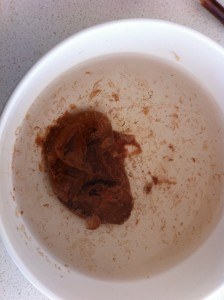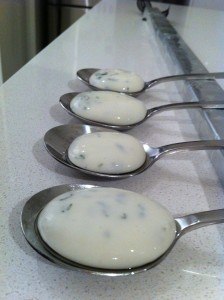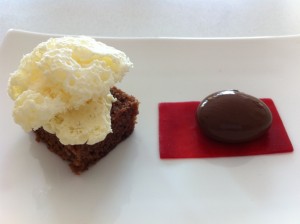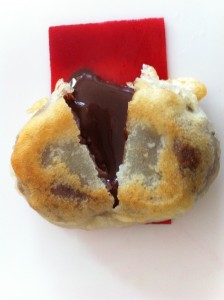The kids loved these sphericals, although I think they may have enjoyed playing with them on their hands even more than eating them.
So how do you make them? Well put simply you add sodium alginate to a container of water and then add calcium salts to the liquid that you want to make into a sphere. The two chemicals react causing the alginate to gel thus encapsulating the liquid. You can do this the other way around and add calcium to the water and sodium alginate to the flavoured liquid.
Sounds simple enough – so why do so many webpages say it is ‘tricky’. Well, because it is if you try to invent your own recipe. The reaction between the alginate and calcium is effected by the level of acid, fat and alcohol in the liquid that you use and is also variable depending on the amount of the additives. So you can spend time and money making a beautiful sauce to spherize only to find when you drop it in the ‘bath’ no gel forms around it and it just disperses in the water making a mess like the one below.


I suggest that you start with yoghurt sphericals as they are the easiest and require the least amount of preparation. Scroll down for chocolate ones.

Yoghurt Sphericals Recipe
Ingredients:
Alginate Bath: 2 g (0.07 ounces) sodium alginate*
500 millilitres (16.91 fluid ounces) or 2 cups distilled water
*sodium alginate is available in molecular gastronomy kits which are available here: Molecular Gastronomy Kits
this one posts to australia too: Molecular Gastronomy Starter Kit with Tools

Yoghurt Sphericals Recipe
Ingredients:
Alginate Bath: 2 g (0.07 ounces) sodium alginate*
500 millilitres (16.91 fluid ounces) or 2 cups distilled water
*sodium alginate is available in molecular gastronomy kits which are available here: Molecular Gastronomy Kits
this one posts to australia too: Molecular Gastronomy Starter Kit with Tools
Filling: high calcium plain yoghurt
freshly chopped mint
Make your sodium alginate bath by mixing in a blender until fully dispersed, place in the fridge overnight. There are small amounts of calcium in tap water so it does need to be distilled water – look in the ironing section of the store).
freshly chopped mint
Make your sodium alginate bath by mixing in a blender until fully dispersed, place in the fridge overnight. There are small amounts of calcium in tap water so it does need to be distilled water – look in the ironing section of the store).
Mix the mint and yoghurt together. Using a round measuring spoon get a scoop of yoghurt, wipe the bottom of the spoon clean, place the bottom of the spoon in the bath and then tip the yoghurt in. Leave for a few minutes, stirring occasionally. Stirring allows the gel to form evenly on all sides which helps avoid holes. Remove the sphericals from the alginate bath and place in a bowl of water to rinse.
There are not many dessert spherical recipes out there, most websites simply seem to repeat a previous one.

After some experimenting I finally had success with these chocolate sphericals. Pictured above with raspberry gel, choc brownie and frozen vanilla air.

After some experimenting I finally had success with these chocolate sphericals. Pictured above with raspberry gel, choc brownie and frozen vanilla air.
Chocolate Spherical Recipe
Calcium Bath: 1 litre (0.26 gallons) or 4 cups water and 8g (0.28 ounces) calcium lactate
Filling: 250 millilitres (8.45 fluid ounces) or 1 cup water small pinch sodium bicarb 1.8 g (0.06 ounces) Sodium Alginate 250 g (8.82 ounces) dark chocolate
Blend water and sodium citrate in a large bowl. Add the sodium alginate and blend again. Put in a saucepan and heat without boiling. Break the chocolate into a bowl and pour the sodium alginate mixture over the chocolate. Allow to sit and then whisk together the chocolate and liquid.
Place spoonfuls into the calcium bath and allow to sit for 10 minutes. Remove and rinse in water bath.

Unexpectedly the encasing alginate gel is heat stable, so they can be coated in batter and fried. This tastes good but looses the elegant look.
 I did not love the chocolate sauce in this recipe so I tried reverse spherification (high calcium liquid dropped into an alginate bath) with both chocolate ganache and chocolate custard both with no luck. It did not form a proper gel casing no matter how long I left it for. It did gel but it was not strong enough to plate.
I did not love the chocolate sauce in this recipe so I tried reverse spherification (high calcium liquid dropped into an alginate bath) with both chocolate ganache and chocolate custard both with no luck. It did not form a proper gel casing no matter how long I left it for. It did gel but it was not strong enough to plate.
For those interested in experimenting further, the closest I got was using the custard recipe below and mixing in 200g (7.05 ounces) dark chocolate into the hot custard. The resulting chocolate custard was delicious but would not gel. I added some water (thinking that perhaps the fat content was too high and the calcium could not leach out of the mixture) and a sprinkle of citric acid. This enabled enough of a gel to form that I could put the sphericals in water to rinse – but when I tried to plate it would form a tiny tear and spill.
Resource: howtocookthat
Không có nhận xét nào:
Đăng nhận xét